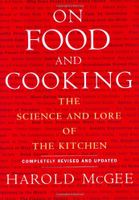Advertisement
Creating Color from Tannins
By Harold McGee
Published 2004
On rare and wonderful occasions, cooking can actually create anthocyanins: in fact, it transforms touch into color! Colorless quince slices cooked in a sugar syrup lose their astringency and develop a ruby-like color and translucency. Quinces and certain varieties of pear are especially rich in phenolic chemicals, including aggregates (proanthocyanidins) of from 2 to 20 anthocyanin-like subunits. The aggregates are the right size to cross-link and coagulate proteins, so they feel astringent in our mouth. When these fruits are cooked for a long time, the combination of heat and acidity causes the subunits to break off one by one; and then oxygen from the air reacts with the subunits to form true anthocyanins: so the tannic, pale fruits become more gentle-tasting and anything from pale pink to deep red. (Interestingly, the similar development of pinkness in canned pears is considered discoloration. It’s accentuated by tin in unenameled cans.)


